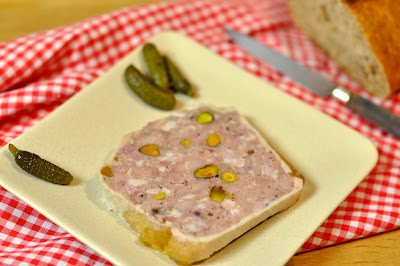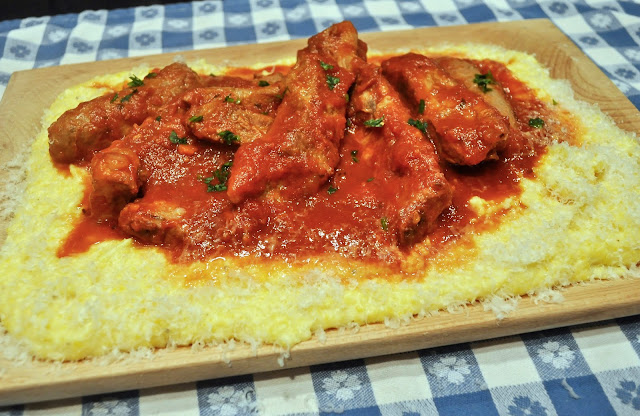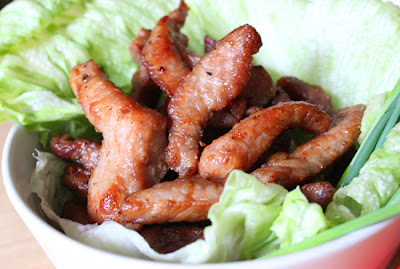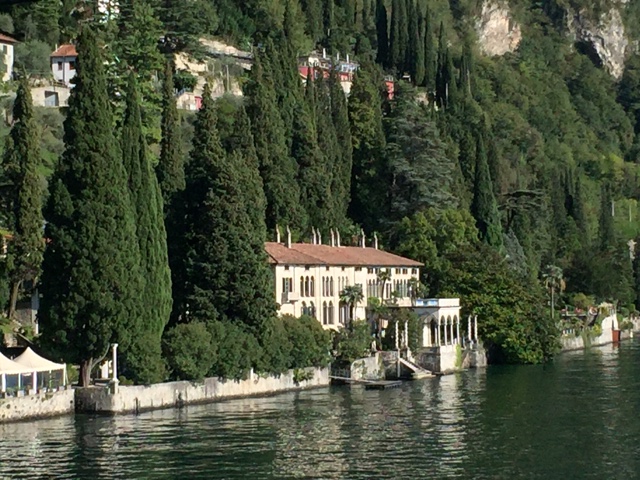Duck Pâté
I don't know if this is due to my lyonnaise origins (Lyon is renown for its fine charcuterie, or deli meats), but if you ask me what my favorite food is, there is a good chance I'll answer pâté (pronounced pah-TAY). It's hard to explain, but just thinking of it makes me salivate.
There are all kinds of pâtés. Some can be spread on bread, others are sliced and eaten with a fork and knife, like this one. Some are baked in a crust (my favorite). Others are baked in a terra cotta or ceramic dish, called a terrine. Although originally a country dish, they can be very refined—some contain truffles, foie gras, or other fancy ingredients. There's one for every taste (and in my case, I love them all!). If you ever go to France, stop in a charcuterie-traiteur (deli shop) and try a few. Each region has its own specialties.
Since I am far from France, I make my own pâté from time to time. I tried various recipes over the years, but the one I'm about to give is my favorite. I found the recipe in a wonderful little French book called Terrines by Catherine Quévremont (Marabout, 2002). My first attempt was quite an adventure. I bought a whole duck, removed the skin very carefully so it remained in one piece, and then cut out all the bones... I spent the whole day fighting with this duck. I waited a few years before doing it again, and spent another frustrating day in the kitchen... The result was well worth my efforts, but the following time (several years later), I decided to cut a few corners (and I also adapted the spices and meat cuts to what's available here), and the pâté still tasted amazingly good.
Here is what I did:
48 hours in advance
Serves 8
Here is what I did:
48 hours in advance
Serves 8
- 4 duck breasts with skin (about 2.2 lbs or 1 kg)
- 12 oz (350g) salt pork
- 10 oz (300g) veal for stew
- 1/2 TBSP salt
- black pepper (about 40 grinds)
- about 25 white peppercorns, crushed in a mortar
- 3 cloves, crushed in a mortar
- 1/2 tsp ground ginger
- 1/4 tsp nutmeg
- 1 egg
- 1 TBSP Cognac
- 1 or 2 handfulls shelled pistachios (dry-roasted, unsalted)
- 3 bay leaves
- Cut the salt pork in cubes and immerse in water several times to rinse off some of the salt.
- Gently pull off the skin of the duck breasts. Make sure to keep the skins in one piece, as they will be used to line the terrine dish. Use the tip of a sharp knife if needed to lift off the skin from the breasts.
- Grind three breasts out of four, as well as the veal and salt pork, using the large plate of a meat grinder* (or cut in small pieces with a knife).
- Cut the fourth breast in 1/2" cubes.
- Place all the meats in a large bowl. Add the salt and spices, egg, and Cognac. Mix well by using two forks (one in each hand) until homogenous.
- Add the pistachios and mix again.
- Line the terrine dish** with three pieces of duck skin. Place one skin at the bottom (with the outside of the skin facing down), and two skins on the sides (with the outside of the skin facing outward).
- Fill up the terrine with the meat mixture. Press to remove any air pockets.
- Place the last piece of skin on top. Place the bay leaves on the skin. Close the terrine with its lid.
- Place the terrine dish in an oven-safe dish, and fill this one with water (at least 1" of water).
- Bake for 1 hour 45 minutes at 350ºF (280ºC). Let the pâté cool down in the oven. Remove the dish with water and keep the terrine in the fridge for at least 48 hours.
- To serve, cut thick slices. Remove the congealed grease. Serve with good bread and cornichons (French gherkins). Make sure to eat the jelly (it's delicious!), but don't eat the skin.
* I have a manual, tinned cast iron meat grinder made in Czech Republic by Porkert, and I love it.
** I just measured my terrine dish (from Ikea). It holds 48 ounces (1.5 quarts) and is roughly 9" long, 5" wide, and 4.5" high.




Comments
Post a Comment